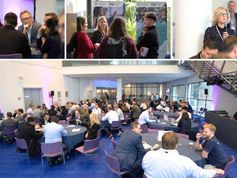Energy procurement: How can manufacturers get ahead of the game?
Businesses continue to face soaring energy costs. The scale and speed of the crisis have prompted many to rethink their energy strategy with a strong emphasis on reducing consumption and security of supply.
Paul Andrews, Director of Global Energy at Smith+Nephew, took the time to share his experience of leveraging the advantages of combining self-generation with external partnerships and how this saved >£7M in 2022 with a further £14M in 2023 forecast!

Manufacturers have seen their energy costs spiral out of control. Research shows that two in five saw their electricity bills rise by 100% in 2022 and one in three saw gas prices increase by more than 100% in the same period.
Worryingly, despite targeted interventions by the UK government, energy costs continue to be a major cause for concern within boardrooms. More than half of decision-makers expect their energy bills to increase by a further 100% over the next 12 months. For many, the cost crisis is threatening the very existence of their business.
As a result, manufacturers are stepping up efforts to reduce consumption, upgrade machinery and buildings and move to renewable sources of energy. This is a journey Smith+Nephew has been on for some years.

The med-tech giant has committed to reaching Net Zero Scope 1 and Scope 2 by 2040 and Scope 3 by 2045. More pressingly, it is aiming to achieve a 70% reduction in Scope 1 and Scope 2 emissions by 2025 compared to a 2019 baseline.
These are already challenging targets made more difficult by the size and scale of Smith+Nephew’s footprint – 18,000 employees, a highly complex global procurement network and a presence in more than 100 countries.
As the lead for global energy and carbon strategy, Paul Andrews is responsible for ensuring these targets are hit.
Impressively, despite the well-documented energy headwinds, Smith+Nephew saved more than £7m in 2022 with a further £14m of savings forecast for 2023.
This was achieved thanks to an integrated energy strategy combining:
Maximising energy efficiencies
On-site renewable generation and storage
Deploying technologies and external specialists to better monitor and control energy usage and wastage
Partnership
Paul shared his experiences of working with a progressive energy consultant and extolled the virtues of finding somebody you can trust. Recent price spikes would have seen Smith+Nephew’s energy spend in the UK trebling from £3m to £4m to between £10m and £12m.
Thanks to its energy partner, that increase has been delayed until 2024. By this time, the energy market is expected to have largely stabilised.
Paul’s advice is to engage key stakeholders in your organisation and set a clearly defined strategy, one which includes both near-term and long-term actions.
“Keep an eye on the market, check your invoices, look ahead to contract renewals and regularly review your consumption. Spotting an irregularity is a lot easier if you fully understand every part of your bill, not just the bottom total figure.”
Efficiency
Paul suggested that, where possible, businesses should look to automate processes; “People are fallible and, more importantly, they love to twiddle. A maintenance engineer may intentionally programme a machine to operate beyond the optimum set level and then forget to reset it once finished.”
To avoid this happening, Smith+Nephew has implemented a regular factory reset where all machines are reverted to standard factory settings to eliminate all the ‘tweaks and fiddling.’
As an organisation, Smith+Nephew is a “religious survey taker,” Paul explained, everything is measured either internally or by external companies. A thorough audit carried out by a specialist won’t be cheap; however, in Paul’s experience, any cost is swiftly returned through savings identified – often multiple times over. An energy audit costing £20,000 identified savings worth more than £250,000, for example.
He also discussed the benefits of implementing a Building Management System, noting that even the most basic can deliver powerful returns. These computer-based systems control and monitor a building’s environmental equipment such as lighting, heating, ventilation and energy supply. An automated BMS can help an organisation become more energy efficient by minimising usage and wastage.
“The great thing about energy efficiencies is they not only generate cost-savings but also carbon savings,” Paul noted.
Self-generation
On-site energy self-generation, particularly solar and wind power, has become an increasingly attractive proposition to manufacturers. Smith+Nephew is no different and has already assessed the potential for on-site renewables.
The company is also putting in place long-term power purchase agreements to source power from new renewable resources. A PPA is a long-term contract between an energy provider and a customer that provides energy at a fixed cost typically below market rates.
There are two types of PPA – on-site and off-site. An on-site PPA is when a renewable energy source like a solar panel installation or wind turbine is installed on the customer’s site. Typically, the energy provider funds the installation and operation of the equipment, and the site owner pays a fixed price for some, or all of the energy produced over the life of the agreement.
An off-site PPA is largely the same, except the renewable energy source isn’t installed on the customer’s site. Depending on exactly where it is installed in relation to the customer, energy can be delivered through a private wire – something Smith+Nephew is exploring.
A primary benefit of PPAs, whether on or off-site, is the long-term security provided. Energy prices may have begun to fall, but this won’t be the last time we experience a spike. With more companies aiming to become energy self-sufficient while reducing their carbon footprint, Paul predicted that PPAs will likely become more commonplace.






Comments